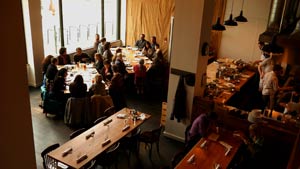by Kathleen Bauer
Clark Haass is bent on world domination, but not in the evil-overlord, bwa-ha-ha sense. He wants to bring the world to the table over a heaping plate of hash.
A senior business development manager for Intel, he spends his working hours in the capital division overseeing investments and acquisitions. But after work and on weekends, Clark Kent-like, he becomes Master of Hashcapades, crusader for a food he considers misunderstood and underappreciated.
It may have something to do with growing up in a family of six kids, where his mom took a break during the summer to go to art school, leaving his dad in charge of the tribe. Clark became known for what he called his “gourmet cinnamon toast,” recalling that later on his dad also taught him to cut up a chicken and make dinner.
Eventually Haass became a father of three himself, saying his “aha!” moment with hash came when he and his family went to the now-closed Roux restaurant in Portland and he ordered their trout hash. Its silky, lush texture combined with the salty smoked fish was an epiphany, and he vowed to recreate the dish at home.
Of his first efforts, he said, “It was good but it didn’t have the right combination of spices.” Single-mindedly he kept working at it, substituting smoked salmon for the trout and adding crême fraiche, dill and half sweet potatoes, half white potatoes to achieve the the dish he’d imagined.
Soon after, an article in the New York Times about hash caught his eye. In it, he found that writer Julia Moskin had put his quest into words: “Friendly to home cooks and on the upswing with chefs, who make it from corned beef, pastrami, Texas barbecue, leftover prime rib, lamb necks or duck tongues, hash is thrillingly easy to cook and deeply satisfying to eat.”
Haass said the article hit him like a ton of bricks, and he thought, “Holy cow, someone needs to write a book about hash.”
By this time, Haass had started meeting friends at restaurants to try different kinds of hash, gatherings he christened “Hashcapades,” that soon became local sensations. Promoted over social media like Facebook and Twitter, they gave him the opportunity to see how local chefs were interpreting the humble hash and to brainstorm ideas for new hashes with fellow enthusiasts.
Collecting these ideas and rigorously testing them in his home kitchen, he assembled recipes that fit his criteria for a balance of flavors, ingredients and lushness. He released the book titled “Hashcapades: The Art of the Perfect Hash Adventure” in 2012. As for what his next quest will be, he’s not thinking small.
“I’d like to see Hashcapades be something bigger,” he said. To that end, he’s donating a dollar for every book sold to Graph It Forward Today (GIFT), an organization that provides graphing calculators and educational support to underprivileged high school students.
And World Hash Domination?
“I want to see people all over the country gathering over hash, creating communities and networking,” he said, smiling about the reactions he’s witnessed on people’s faces as they experienced non-processed hash for the first time. “It’s all about people thinking outside the can.”
Kathleen Bauer is a freelance writer in Portland, Oregon, focusing on agriculture and field-to-plate issues. Her blog, Good Stuff NW, is about her journey to connect the dots between what happening in the field and what she’s putting on her table, including stories about people who are making a difference in our local food system, about eating sustainably and locally, and about the political issues affecting the food we find at our markets and stores.
Most of the videos featured on Cooking Up a Story were produced, filmed, and edited by Rebecca Gerendasy. Fred Gerendasy contributed as a writer to many of the posts and occasionally as the interviewer. Visit Rebecca Gerendasy Clay – Art and Fred Gerendasy Photography to see their current work.


